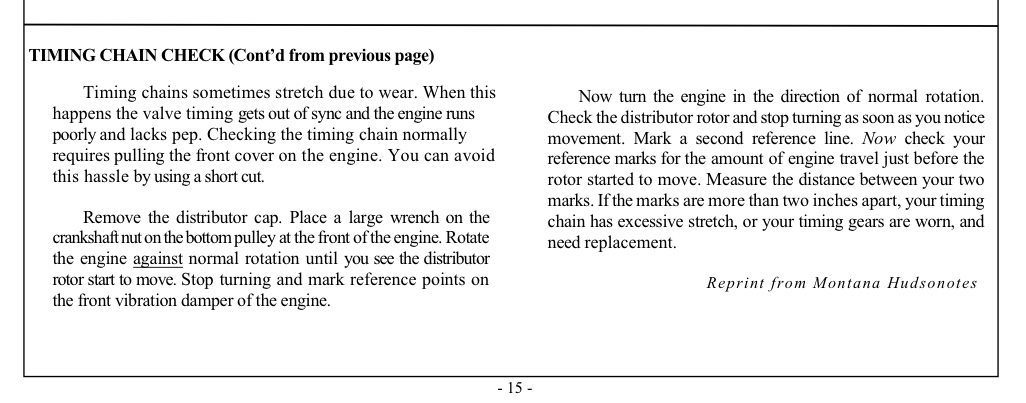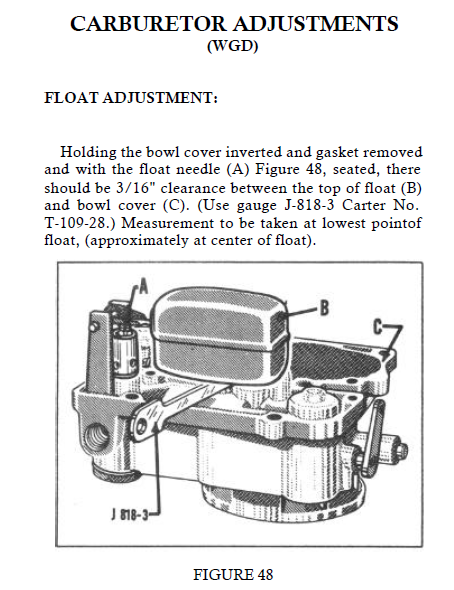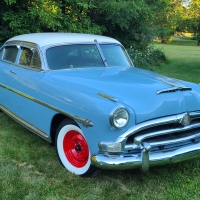Spark Plugs for 232 and 308 and possible timing chain slip
in HUDSON
In the 1948-52 manual they say Hudsons use Champion H-8 for the 232, 262, & 254 engines and Champion H-11 for the 308. I have heard Champion plugs today are not made as well as the old ones. I heard once they foul out they do not work even after cleaning them. Is anyone using a different brand and finding they work better? Or is everyone having good luck with the Champions? I am having a lot of trouble with my 308 all of the sudden. I don't know the history of the engine I have and I got it running after it sat for who knows how long. I timed it and it fired up with barely cranking at all. Then after a few days of driving it around it started to progressively get worse. It acts as though its only firing on a couple cylinders. I timed it the way the book says and the plugs keep fouling out. When I pulled the plugs they are black and wet. So I though maybe the Carter WGD 2 barrel had a needle not set properly and was causing the engine to flood. I took the carb apart, cleaned it, put it all back together and it acts the same. I can not run it long enough to see if gas is just leaking down into the intake at idle from a possible stuck needle. Could it be possible the timing chain slipped and without opening the engine up is there anything else I can check before taking the timing cover off? Thanks,
Ken
Ken
0
Comments
-
On my 1951 262 I have used Champion H10C and NGK B6L. In my opinion, the NGK B6L is a better quality plug.
Before I rebuilt my engine last year - less than 6 months after I bought the car - I had a similar issue. The primary problem with firing was the distributor itself. The shaft was bent and/or the bushings were worn out. The situation was bad enough that the rotor would sometimes crash into the points of the distributor cap leaving behind obvious wear marks. The plugs were fouling because they weren't energizing on every power stroke. Check your cap and rotor for unusual wear.
One other likely electronic issue, assuming good plugs, plug wires, and distributor is the coil itself. When the coil starts to go bad it doesn't fire every time, which could create this condition. If you are still on the original 6 volt configuration the NAPA ECH IC7 is a good quality coil still available.
I doubt your timing chain has slipped, but it is probably stretched. Timing by timing light is difficult and not optimal. This gentleman (Ken Cates) has posted all sorts of helpful tidbits including timing by vacuum, which is a much better way to go:
https://hudsonrestoration1948-54.com/IgntionSystem.htm
The brass timing gear on the oil pump is a sacrificial part. As the teeth wear, the timing will get worse. This is possibly worn out on your engine and will contribute to bad timing. This might be felt by attempting to twist the distributor rotor (don't twist so hard as to pull the springs in the mechanical advance).
Good luck.
Chris0 -
GET NGK B7HS
0 -
Thanks for the info. I'll pickup some NGK's and try again. I have swapped coil, cap & rotor with another running car and it made no difference. I did notice the rotor does have quite a bit of rotational play meaning, I can twist the rotor by hand some, not sure how much play is acceptable. Also, I have about 80 psi compression at each cylinder and the book says I should have at least 100 psi. If the timing chain stretched or slipped would it cause a loss in compression? . I'll do some reading on the link you shared. Thanks again0
-
It'll run with 80 and less0
-
ok I replaced the plugs with NGK B7HS, gapped at .032 brought no 1 cylinder up to TDC and with the key on I rotated the distributor until I got a spark on the no 1 plug. Started the engine and it ran rough. Like it was still not running on all cylinders. I tried to check the timing with a light but it did not flash consistently. Then I looked down inside the carb while it was running and noticed gas was dripping through the venturi. Within a few minutes it died and would not restart. I'm guessing the WGD carb is the problem and probably needs to be rebuilt? I took the cover off the carb to see the metering rods. I tried to adjust them the way its explained here:
http://www.carburetor-parts.com/Carter-WGD-Technical_ep_316.html
The metering rods do not seem to seat all the way down into the seats/jets? I held them all the way down and tightened the metering rod set screw but after letting go the rods raise up a little. I tested the throttle and it does raise the rods up and lower them down with the throttle but they do not seem to seat all the way down. Is this normal?
Thanks again for the help,
Ken0 -
ok if I need to replace the distributor drive gear, where is the best place to buy a new one along with the gaskets needed? Thanks0
-
There may be two tasks to be performed here. One is removing the old gear - needs to be drilled out on opposite side of pin so it can be driven out of blind hole. Second is timing of distributor firing order is upset upon removing oil pump and needs offset gear tang slot to be set when new gear and pump replaced. Check shop manual. Am I correct on this ?0
-
How old are the distributor cap and rotor. Mine looked great until i compared them to a new ones and found the rotor was worn a good 1/8" shorter than the new one. My misfire went away after replacement.0
-
I can think of three vendors that carry the gear and oil pump gaskets (I am sure there are more):
21stcenturyhudson.com
wrphet.com/
hudsonmotorcarco.com0 -
I have compared the amount of rotational play in the distributor by turning the rotor on 2 different hudson engines that run just fine and the play is pretty much the same so I do not believe the distributor drive gear is the culprit. Yesterday I brought the no. 1 piston to TDC by bumping the starter while holding my finger over the no. 1 spark plug hole, then manually turned the engine until the long UDC timing mark was aligned with the pointer at the flywheel. Then I rotated the distributor until I had a spark at the no. 1 spark plug. That was enough to get the engine to fire up. After running at idle I try to rev the engine and it immediately loses vacuum and wants to die. I am unfamiliar with this behavior. Should I pull the timing chain cover and see if the chain is stretched and or possibly slipped a tooth? Here's a video of the engine barely running.
 https://youtu.be/dyPgsvJkV6U
https://youtu.be/dyPgsvJkV6U
Thanks for any help/advise.
Ken0 -
You can usually " Feel" play in the timing chain. Use a socket and breaker bar on the Damper nut and turn it until you get resistance. Now turn it counter clockwise and you'll know how much play you have in the chain.
Did you check for vacuum leaks at the intake and adjust the valves?
Both will cause your symptoms0 -
I'll rotate the crank bolt and see if I can feel slop in the chain. Thanks.
When I first got the engine running it sounded like a diesel. Then I adjusted the valves on the engine cold, .011 intake and .014 exhaust - advise from the guys at Wildrick. It quieted down significantly and ran better after the valve adjustment. I could not tell if there is a vacuum leak. Did you notice in the video looking down into the carb you can see fuel dripping down through the venturies? Is that normal?0 -
No, that is not normal. You need to have your carb rebuilt.0
-
Attached is an excerpt from tech tips provided by Larry Cramer which are posted on my website.
 0
0 -
Thank you! I will try this timing chain check and see about rebuilding the carb.0
-
Sounds like the carb float is set too high and raw gas is slopping into the intake. Geoff Clark says to lower the float (1/8 I think) to allow for the new gas being lighter weight and not raising the float enough. Also check the needle valve. Some of them have a rubber tip that can leak and/or trap crap. Don't want that leaking needle-lessly. har har
0 -
I did set the float to 3/16" so maybe lowering it would help. Thanks0
-
I set it the way the shop manual shows. The 2 barrel WGD carb measures from the carb body to the bottom of the bowl held upside down, not to the soldered seam like the 1 barrel. Why would the book be incorrect?

0 -
The book is incorrect insofar as the gas today is a different specific gravity from back in the fifties. Being lighter S.G. the float actually sits lower in the fuel, hence the level is higher.0
-
So what is the consensus on the float measurement for the fuel used today?0
Categories
- 36.9K All Categories
- 112 Hudson 1916 - 1929
- 20 Upcoming Events
- 92 Essex Super 6
- 28.6K HUDSON
- 571 "How To" - Skills, mechanical and other wise
- 995 Street Rods
- 151 American Motors
- 178 The Flathead Forum
- 49 Manuals, etc,.
- 78 Hudson 8
- 44 FORUM - Instructions and Tips on using the forum
- 2.8K CLASSIFIEDS
- 608 Vehicles
- 2.1K Parts & Pieces
- 77 Literature & Memorabilia
- Hudson 1916 - 1929 Yahoo Groups Archived Photos




